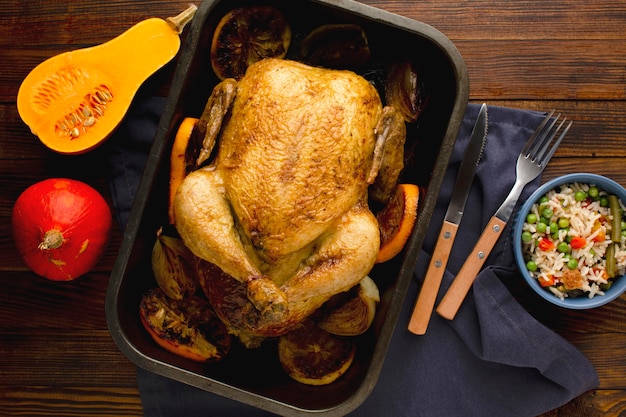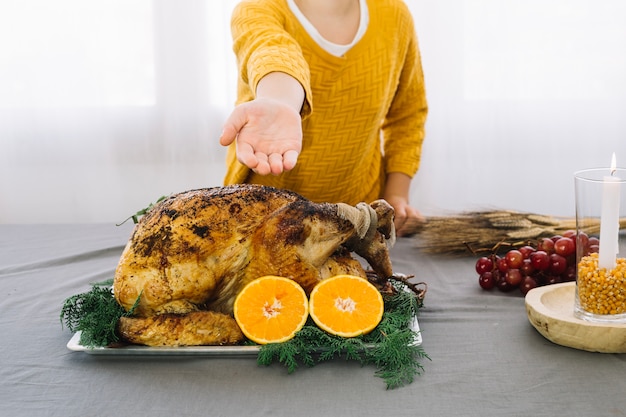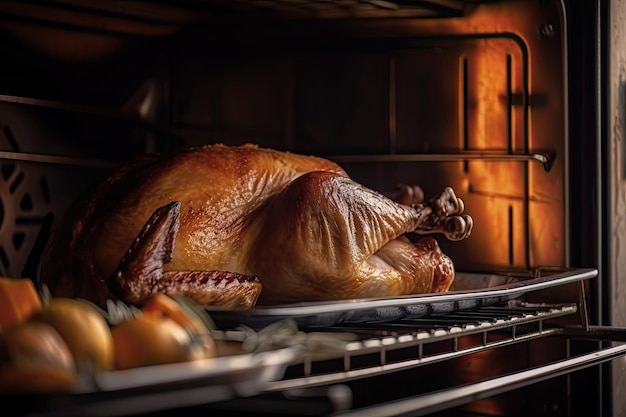Let's talk about roasting a whole chicken, a classic dish that always impresses. It's one of those things that seems intimidating, but it's actually quite straightforward and rewarding. The aroma alone is enough to make your mouth water, and the succulent results are a surefire way to bring warmth and comfort to any occasion. Plus, it's a true crowd-pleaser!
I’ve been roasting chickens for years, and I've learned a thing or two along the way. It all starts with a good quality chicken. I usually go for organic, free-range, because I find it has a more intense flavour, but you do what feels right for you. Once you’ve got your bird, you'll need to get it ready for the oven. Some folks like to stuff their chickens, but I find it can get messy, so I usually stick to a simple rub on the skin. But we'll get into that later.
(Part 1) Preparing Your Chicken

First, pat the chicken dry with some kitchen paper. This simple step makes a huge difference - it helps the skin to crisp up beautifully. Now, you need to decide if you want to truss the chicken. Trussing is basically tying the legs and wings together with string, which helps it cook more evenly. It’s also meant to make it look prettier, which is always a bonus, right?
I used to think trussing was some kind of culinary magic trick, but it's not. You just need a bit of string, some good kitchen scissors, and a bit of patience. Don't worry if you've never done it before, there are tons of videos on YouTube that can walk you through it. For me, trussing is worth the extra effort, but if you’re pressed for time, it's not essential.
Choosing the Right Pan
Next, you'll need a roasting pan. I’ve got a trusty cast iron one that I absolutely love, but any ovenproof dish will do the job. Just make sure it's big enough to fit the chicken comfortably, with some space around it. You want the hot air to circulate, which helps the chicken cook evenly. And while we’re on the subject, why not add some vegetables to the pan? It’s like a free side dish! I usually throw in some potatoes, onions, carrots, and maybe a few garlic cloves.
Seasoning and Rubs
Now for the fun part – seasoning! This is where you get to be creative with your chicken. Some people like to keep things simple with just salt and pepper, while others go for something more adventurous. I usually use a blend of herbs and spices, like rosemary, thyme, garlic powder, paprika, and a bit of cayenne pepper for a touch of heat. You can also add some citrus zest, or even a bit of honey. Don't be afraid to experiment!
If you're feeling fancy, you can make your own rub. Just mix together your favourite herbs and spices, then rub them all over the chicken. You can even make a paste by mixing it with a little bit of olive oil, which really helps the flavour penetrate the skin. This is where personal preference comes in. My go-to is a simple blend of garlic powder, paprika, and a bit of smoked paprika for a nice smoky flavour. It’s absolutely delicious.
(Part 2) Roasting Your Chicken

Now, preheat your oven to 180 degrees Celsius (or 350 degrees fahrenheit). This is the temperature that works best for me, but feel free to adjust it based on your oven and preferences. While the oven is heating up, you can prep your vegetables. As I mentioned, I like to add potatoes, onions, carrots, and garlic cloves. A drizzle of olive oil and a sprinkle of salt and pepper, and you're good to go.
Placement and cooking time
Place your chicken in the roasting pan, breast side up. This is important because it helps the breast meat cook evenly. And make sure the chicken is placed on a rack in the pan, not directly on the bottom. This will help the chicken cook more evenly and prevent it from steaming, which can make the skin soggy. Now, let it cook for about 1 hour and 15 minutes.
This is just a general guideline, though. Always check the internal temperature of the chicken to make sure it’s cooked through. You can use a meat thermometer, or just poke the thickest part of the thigh. If the juices run clear, it's ready. I know it's tempting to cut into the chicken to check, but resist! You want to keep all those lovely juices locked in.
Resting Time
Once the chicken is cooked, take it out of the oven and let it rest for about 10 minutes before carving. This is super important! It allows the juices to redistribute throughout the meat, making it even more tender and juicy. It also gives you time to make gravy, which is a must-have with roasted chicken. I know it's a bit of extra work, but it’s so worth it.
(Part 3) Carving and Serving

After the chicken has rested, you can finally carve it. This is another skill that takes a bit of practice, but you'll get the hang of it. Start by removing the legs and thighs. Then, cut the breast into smaller pieces. Don't forget to scoop out the juices from the pan and make gravy! I know, I know, I promised to talk about gravy, and I will, but first, let’s talk about serving suggestions.
Serving Suggestions
You can serve the chicken with whatever you like. It goes perfectly with roast vegetables, mashed potatoes, green beans, and gravy, of course. You can even add a bit of cranberry sauce or a salad for a bit of extra flavour. It really depends on what you’re in the mood for. I’m quite a simple person, so I usually just serve it with some roast potatoes, gravy, and a simple green salad. And my family seems to like it this way too.
(Part 4) Making Gravy
Now, let’s talk about that gravy! It’s honestly the best part of the whole roasting chicken experience. I'm not going to lie, it can be a bit intimidating, but it's actually really easy. Once you've carved your chicken, you need to make a pan sauce. This is basically the magic juice left over in your roasting pan. It’s pure flavour gold.
Making the Pan Sauce
You'll need to deglaze the pan. You do this by adding a little bit of wine or broth to the pan and scraping up all the delicious brown bits stuck to the bottom. This is the essence of flavour, so don't skip this step. Let the liquid simmer for a few minutes, then remove it from the heat. You can then add a tablespoon of butter and a tablespoon of flour. Whisk it together until it forms a smooth paste. Now, slowly whisk in the liquid you used to deglaze the pan, and continue to whisk until it thickens nicely.
You can add more liquid if needed, but you want a good gravy consistency. Season it with salt and pepper to taste. If you want a really rich gravy, you can add a dollop of cream or a little bit of mustard. Honestly, you can add whatever you like! It’s your gravy, so make it your own. I usually add a tablespoon of Dijon mustard to mine. It adds a nice bit of tang.
(Part 5) Tips and Tricks
Right, now for some tips and tricks. I've learned a lot over the years. It's like a never-ending learning curve, this whole cooking thing. But there are a few things that really make a difference when it comes to roasting chicken. First off, use a good quality chicken. This is the foundation of a delicious roast chicken. The chicken I buy from the local butcher is always amazing. It's a little more expensive, but it's definitely worth it.
Secondly, don't overcrowd the pan. Give your chicken enough space to breathe. You want the heat to circulate all around it, which will help it cook more evenly. Third, use a meat thermometer. This is the best way to make sure your chicken is cooked through. It’s a small investment, but it's worth it, I promise.
Don't Overcook
Fourth, don't overcook the chicken. Overcooked chicken is dry and tough. You want it to be cooked through but still juicy and tender. Fifth, let the chicken rest before carving. This will allow the juices to redistribute throughout the meat. And finally, make gravy! Gravy is a must-have with roast chicken. It adds flavour, moisture, and a touch of elegance. It’s like the finishing touch to the whole experience.
How to Avoid Dry Chicken
I know what you're thinking - dry chicken is a real bummer. It’s the worst. I’ve been there! But it doesn't have to happen. There are a few things you can do to avoid dry chicken. First, cook it at a lower temperature for a longer period of time. This will help the chicken to cook more evenly and prevent it from drying out. You can also use a technique called “spatchcocking”, which basically means removing the backbone and flattening the chicken. This allows the chicken to cook faster and more evenly.
(Part 6) FAQs
Right, let’s tackle some frequently asked questions about roasting chicken. I know you’ve got questions, and I’m happy to help! It’s always good to have some answers up your sleeve, especially when it comes to roast chicken. It can be a bit nerve-wracking sometimes, let’s be honest.
Here are some of the most common questions I get asked about roasting chicken:
1. How do I know when my chicken is done?
The best way to know if your chicken is done is to use a meat thermometer. Insert the thermometer into the thickest part of the thigh, not touching the bone. The chicken is done when the internal temperature reaches 165 degrees Fahrenheit (74 degrees Celsius). If you don’t have a thermometer, you can check by cutting into the thickest part of the thigh. The juices should run clear, not pink. You can also give the thigh a good squeeze - it should be firm.
2. How do I make my chicken skin crispy?
You’ve got to have that crispy skin, haven’t you? It’s essential! Here are a few tricks: Pat the chicken dry with kitchen paper before you season it. This helps the skin to crisp up better. You can also rub the skin with a little bit of oil, which will help it to brown nicely. Another trick is to roast the chicken at a higher temperature for the first 30 minutes. This will help to crisp up the skin while the inside cooks. And finally, make sure the chicken is placed on a rack in the roasting pan, not directly on the bottom, so the air can circulate around it and make it nice and crispy.
3. What can I do with leftover roast chicken?
Leftover roast chicken is like a culinary gift from the gods. It’s so versatile, you can do all sorts with it. You can use it in salads, sandwiches, soups, or even make a chicken pot pie. The possibilities are endless!
4. Can I roast a frozen chicken?
Technically, yes, you can roast a frozen chicken. But it’s not ideal. The chicken will take a lot longer to cook, and the skin might not be as crispy. It’s best to defrost the chicken overnight in the fridge. It's a good idea to place the chicken in a container or wrap it in plastic to catch any drips and to avoid contaminating your other food. This is a much safer way to do it, and it will ensure your chicken is nice and juicy.
5. What are the best vegetables to roast with chicken?
This is a matter of personal preference, but I love to roast potatoes, onions, carrots, and garlic cloves with my chicken. These vegetables are perfect for roasting because they get nice and caramelized. They absorb all the delicious juices from the chicken, creating a flavour explosion in your mouth!
(Part 7) The Secret to a perfect roast Chicken
As I’ve mentioned before, it’s all about the seasoning. A simple rub of salt, pepper, and your favourite herbs and spices can really elevate the flavour of your chicken. You can get really creative with your rubs. Try adding garlic powder, paprika, thyme, rosemary, and a pinch of cayenne pepper for a bit of a kick. It’s up to you! You can even experiment with different types of peppercorns, like black peppercorns, white peppercorns, or even pink peppercorns.
A little bit of citrus zest can add a lovely freshness to your chicken. You can also add a tablespoon of honey for a bit of sweetness, which goes really well with the saltiness of the chicken. If you want a more rustic flavour, try adding some chopped herbs, like rosemary and thyme, to the pan while the chicken is roasting.
(Part 8) A Final Word
roasting a whole chicken might seem intimidating, but it's actually really easy. With a little bit of practice, you can easily master it. It's one of those things that everyone should know how to do, and it's sure to impress your friends and family. Remember, it’s all about the preparation, the seasoning, and the cooking time. And most importantly, don’t be afraid to experiment. Just get in there and have fun! You’ve got this!
And finally, remember the joy of a perfectly roasted chicken: the crispy skin, the juicy meat, the heavenly aroma filling your home. It’s a true testament to the power of food to bring people together. So get out there and roast some chicken! And if you have any questions, just ask. I’m always happy to help.
Everyone is watching

How to Cook Frozen Lobster Tails Perfectly: A Step-by-Step Guide
RecipesLobster. Just the word conjures up images of lavish meals, special occasions, and a taste of luxury. But let's...

Pigs in a Blanket Cooking Time: How Long to Bake for Perfect Results
RecipesAh, pigs in a blanket. Just the name conjures up images of those delightful little parcels of crispy pastry en...

Pork Fillet Cooking Time: How Long to Cook It Perfectly
RecipesPork fillet, or tenderloin as it's sometimes called, is a real favourite in our house. It's so versatile, and...

The Ultimate Guide to Cooking Delicious Frankfurters
RecipesLet's face it, we all love a good frankfurter. It's a classic, simple, and always satisfying. But let's be rea...

Wolf Meat Recipes: A Guide to Cooking Wild Game
RecipesLet's be honest, you don't see wolf meat at your local butcher shop every day. It's a bit of a wild card, but ...
